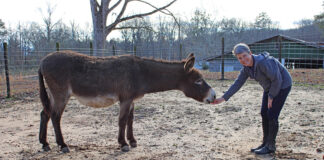The University of California, Davis, School of Veterinary Medicine is the largest public veterinary program in the country with more than 488 students and 300 faculty members. It tied for second with Colorado State University as one of the top veterinary schools in a 2007 report by U.S. News and World Report.
This year, the School of Veterinary Medicine celebrates 60 years of teaching, research and service benefiting animal, human and environmental health.
“There is a lot of evolution going on as far as how our programs will be structured,” says Lynn Narlesky, external communications specialist for the UC Davis School of Veterinary Medicine. “We have an increased role in veterinary public health, food safety and security.”
Unique partnerships with California’s agriculture, health and environmental agencies over the years have helped maximize students’ activities and lessons.
“Our school is strategically located with lab services and programs throughout California,” says Narlesky.
The California Animal Health and Food Supply lab systems established in 1988 to protect California’s food supply, livestock and horses. Labs are now located in Davis, Turlock, Fresno, Tulare and San Bernardino.
The residency program offers 29 specialties from small to large animals including genetics, behavior, orthopedics, animal medicine and neurology.
“Every type of specialty you would have for humans, we have for animals,” says Narlesky. “We have also had the time to develop new specialties.”
In addition to its educational programs, the School of Veterinary Medicine has been recognized for many discoveries including the discovery of dietary taurine in preventing fatal heart ailment in cats, mastitis prevention in dairy cattle, the identification of a gene mutation and the development of a new diagnostic test to eliminate HERDA, and the genetic mutation that causes PKD in Persian cats.
The school also pioneered an animal genetics program in the 1990s to detect genetic diseases, validate pedigrees, solve parentage questions and identify animal evidence to help solve crimes.
At A Glance: Location: Davis, Calif. Opening date: September 1948 Number of students: 500 Website: www.vetmed.ucdavis.edu |
Besides teachings in the lab, classroom and hospital, the school offers learning opportunities outside the classroom including summer research fellowships, international exchanges, bovine experience and externships with large and small animals or wildlife.
Residents also get hands-on training at the William R. Pritchard Veterinary Medical Teaching Hospital which opened in 1970 to teach essential veterinary skills and advanced specialty training to its residents. It now treats more than 30,000 patients per year.
“The residency program allows students to study in various locations so they can work with different groups and get a very broad training,” says Narlesky.
One hundred six women and 25 men were admitted to the 2011 DVM program from a pool of 1,120 applicants last fall. This was an increase in class size from 122 to 131 since 2006.
“We are the best to educate the vets of the future,” says Narlesky. “We want to make sure future scientists have all the research they need.”
———————————–
Click Here for a list of previous Vet School Spotlights.






